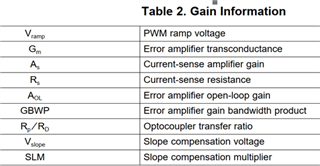Hi team,
I want to use LM5143Q for a IBB design, so I want to calculate the feedback loop.
As the error amplifier is internal, could you share the internal error amplifier parameter as following table?

Thanks.
Best regards
Mia Ma
This thread has been locked.
If you have a related question, please click the "Ask a related question" button in the top right corner. The newly created question will be automatically linked to this question.
Hi team,
I want to use LM5143Q for a IBB design, so I want to calculate the feedback loop.
As the error amplifier is internal, could you share the internal error amplifier parameter as following table?

Thanks.
Best regards
Mia Ma
Hi Mia,
The applicable parameters are given in the datasheet EC table.



The transconductance error amp gain is its gm times the Rout of the amplifier, which is approximately 95dB.
Regards,
Tim
Hi Timothy,
thanks for your reply, here is still three confusing item about LM5143Q during customer calculate IBB compensation as following:

1. Ri=A*Rs, so the 'A' here is cs amplifier gain=12, the 'Rs' is the current sensing resistor value, right?
2. there is a Km=(Vin+Vout)/Vslope,at D=0.5; how to calculation Vslope here?
in our datasheet, there is the SLOPE2=64mv/us at 220k and SLOPE1= 557mv/us at 2.2MHz, what if the frequency is 100k or 400k, how to calculate the matched slope? Besides,Vslope = SLOPE*Period?or Vslope = SLOPE*Period*Duty?
3.In above bode plot, the wz frequency is smaller than wl ; if wz calculated result is larger than wl,if it's reasonable from your view?
Thanks
Best regards
Mia Ma
Mia,
1. Correct.
2. Slope comp increases approximately linearly with Fsw. This means the SLOPE compensation amplitude is roughly constant for a given switching period. The duty cycle is typically not used for that calculation.
3. wz is the high-frequency pole from current-mode control, typically this is above the ESR zero freqeunecy wz. IBB configurations can benefit from an electrolytic cap (with its relatively high ESR) for this reason.
Regards,
Tim
Hi Timothy,
thanks for your quick response:
1. ok
2.as you said that the duty cycle is not used, may I have follow understanding: if the frequency is 220k,SLOPE2=64mv/us, the Vslope= 64mv/us * 4.55us=291mv, right?
3. do you mean 'wl is the high frequency pole from CM control ' here? the wz is just mistypeing.
wz is the high-frequency pole from current-mode control
and it's better to use high ESR out cap for smaller ESR zero frequency, am I in a correct understanding here?
thanks
Best regards
Mia Ma
2. That calculation looks correct.
3. Yes, I meant wl here, and the high ESR cap provides a zero that helps with the effects of the RHP zero applicable to the IBB topology.